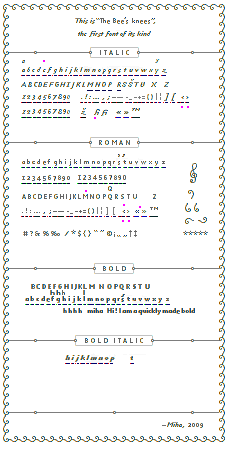Typekit and the Problem with Web Fonts
Being a text-based place, you might expect there to be a wide range of fonts used around the world wide web. Perhaps you’ve noticed that in actuality you’re almost always looking at Arial and Times. This of course drives web designers crazy, and they’ve been trying to get more fonts onto the web for years. The technical aspects of web-embedded fonts are more or less solved, but there’s still the basic problem that font foundries aren’t willing to put their intellectual property into the most copyable place in the universe — the world wide web. Until we find ways around that, web designers are stuck with using the fonts they can count on already being on your computer, basically Arial, Times, Courier, Georgia, and Verdana.
There are certainly ways of putting fonts onto the web as images instead of text, but image-based text has problems around searchability, copy-and-pastability, archivability, translatability, download speed, and access for the visually impaired. So to heck with that (except maybe for titles, maybe). Another option has been to use fonts which are in the public domain, open source, or otherwise licensed for web use. I’ve seen one or two sites that use that approach, but the current limit is the availability of freely usable high quality fonts. I expect to see that limit loosen as more indie and even commercial foundries release web-licensed giveaways, either to be helpful or to get known. I’m also predicting that foundries will start to freely license one or two variants of a font family — say the medium and bold variants — to promote the sale of the professional full-family bundles. For now however, quality free fonts are scarce.
Enter Typekit, which has gone live and large as of this morning. Typekit is a font service for web sites. It doesn’t create images, and it’s not just free fonts. It embeds a copy of a real, licensed typeface definition onto a webpage, allowing browsers to translate the honest-to-god plain text on that site into honest-to-god rendered screen font on user’s screens. So that’s good. In return the website owner pays Typekit a subscription fee, and Typekit pays some of that back to the font foundries they license from. That sounds fair. But I hope it’s not the only long-term solution, because I don’t like the idea of the typography of my websites collapsing back to Arial and Times if the Typekit server ever goes flaky, or if my wallet ever goes flaky. I’m not totally comfortable with the Typekit approach, but as of today it may fairly be said that there are more than five fonts on the internet.
There’s another problem with web typography I didn’t mention above: the low resolution of modern computer screens (roughly 100 dots per inch) makes type look jaggy and blurry compared with good-quality paper printing (roughly 300dpi), but that problem is getting solved in drips and drops every year as screen resolution gradually floats upwards faster than screen sizes do. It’s a slow process, but it will solve itself in the next ten years or so. So that’s something for us all to look forward to: crisp clean screen text, possibly before the mars landing.
